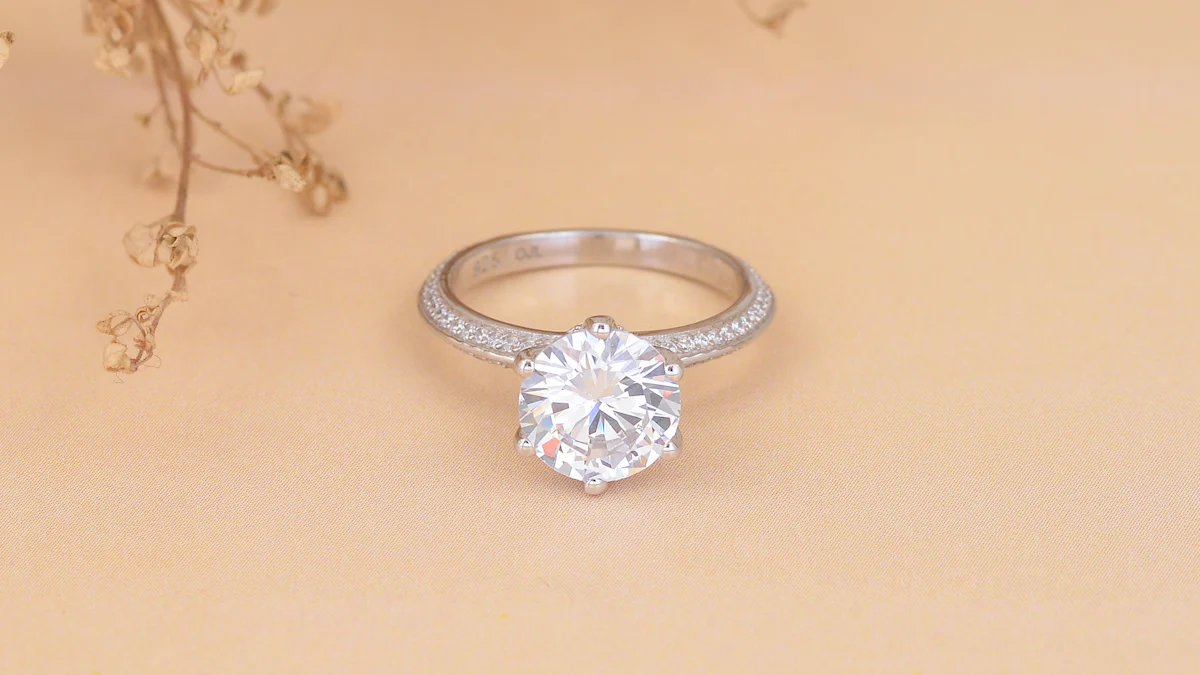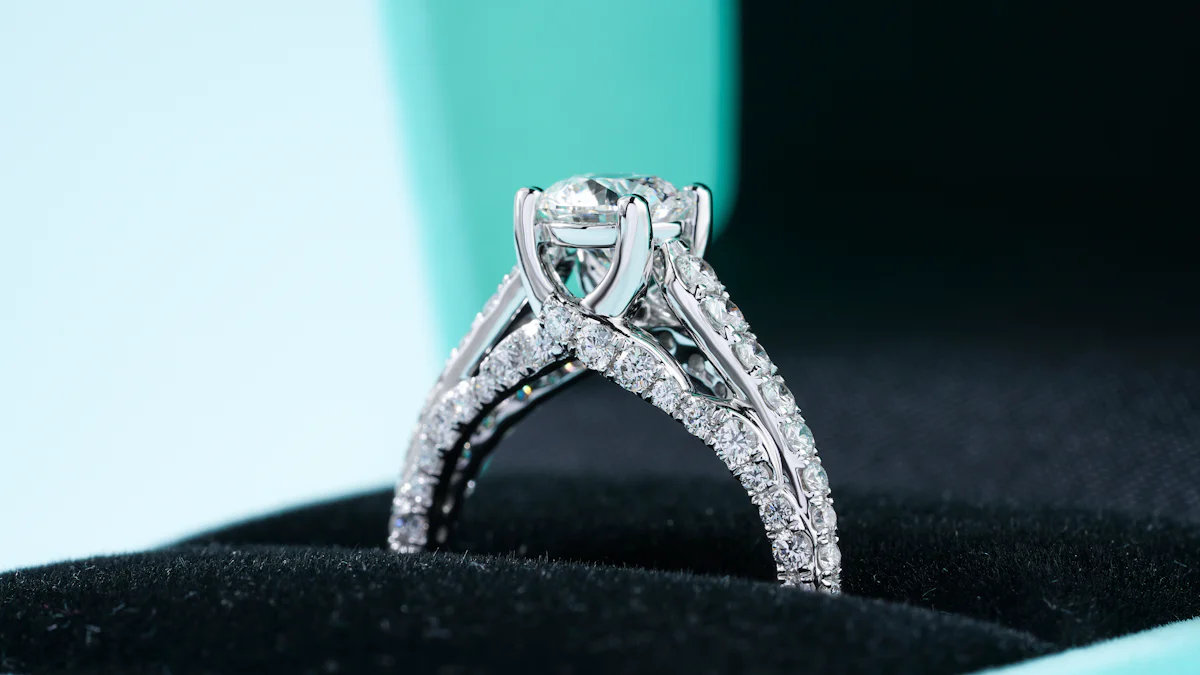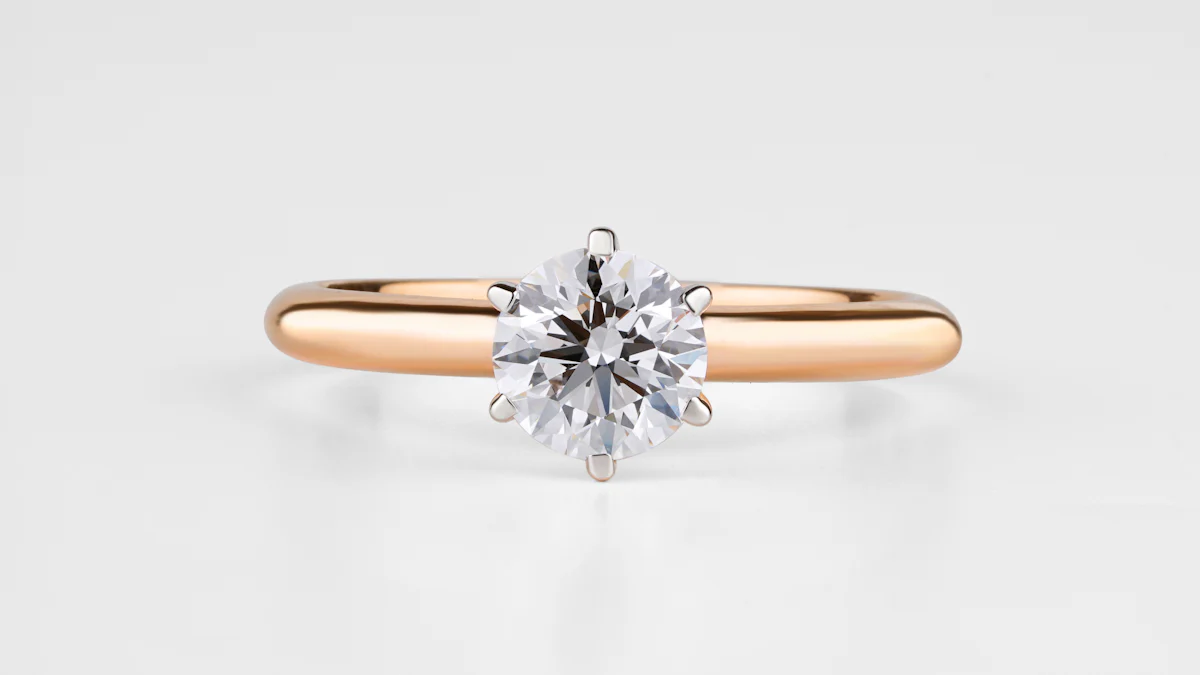A Buyer’s Guide to 1ct Solitaire Diamond Rings

A 1ct solitaire diamond ring is more than just a piece of jewelry. It’s a timeless choice that symbolizes love, commitment, and elegance. Whether you’re planning a proposal or celebrating a milestone, this classic design never goes out of style.
Why are solitaire diamond rings so popular for engagements? For centuries, diamonds have been seen as symbols of everlasting love and purity. Their brilliance reflects the joy and connection shared between couples, making them the perfect emblem of eternal promises. The simplicity of a solitaire setting lets the diamond shine as the centerpiece, creating a look that’s both sophisticated and meaningful.
If you’re looking for a ring that combines beauty, tradition, and emotional significance, a 1 carat solitaire diamond ring is a choice you’ll never regret.
Understanding the 4Cs of a 1 Carat Diamond Ring

When choosing a 1 carat solitaire diamond ring, understanding the 4Cs—Cut, Color, Clarity, and Carat—is essential. These factors determine the beauty, quality, and value of your diamond. Let’s break them down.
Cut: The Key to Brilliance
How cut impacts sparkle and brilliance
The cut of a diamond plays the biggest role in its sparkle. It determines how light interacts with the stone. A well-cut diamond reflects light beautifully, creating that dazzling brilliance you love. Here’s what makes the cut so important:
- Proportions and angles of the facets control how light bounces inside the diamond.
- Symmetry ensures light reflects evenly, while asymmetry can dull the sparkle.
- Ideal cuts maximize brilliance by reflecting light optimally.
Ideal cut grades for a 1ct solitaire diamond ring
For a 1 carat solitaire diamond ring, look for a cut grade of "Very Good" or "Ideal" (for round diamonds). These grades ensure the diamond has harmonious proportions, balancing width, height, and depth. A shallow cut may look larger but lacks depth, while a deep cut can appear smaller. An excellent cut strikes the perfect balance, enhancing both sparkle and diamond size.
Color: Achieving the Perfect Hue
The color grading scale and its effect on appearance
Diamonds are graded on a color scale from D (colorless) to Z (light yellow or brown). Here’s a quick guide:
| Diamond Color Grade: | Description: | | --- | --- | | D | Completely colorless, the highest grade. | | E-F | Nearly colorless, differences visible only to experts. | | G-J | Near colorless, with faint yellow hues noticeable in lower grades. |
Colorless diamonds (D-F) are rare and expensive, while near-colorless options (G-J) offer great value without compromising appearance.
Recommended color grades for a 1 carat solitaire engagement ring
For a 1 carat diamond ring, near-colorless grades like G-I are ideal. They appear white to the naked eye and are more affordable than D-F grades. If you’re choosing a white gold or platinum setting, stick to I or better. For yellow or rose gold, J color works well since the metal’s warmth complements the diamond’s hue.
Clarity: Evaluating Inclusions
Clarity grades and their meaning
Clarity measures how free a diamond is from inclusions (internal flaws) and blemishes. Common clarity grades include:
- Flawless (FL) and Internally Flawless (IF): No visible inclusions, even under magnification.
- Very, Very Slightly Included (VVS1, VVS2): Tiny inclusions, hard to spot.
- Very Slightly Included (VS1, VS2): Minor inclusions, invisible to the naked eye.
- Slightly Included (SI1, SI2): Noticeable inclusions under magnification, sometimes visible.
- Included (I1, I2, I3): Obvious inclusions that affect brilliance.
Higher clarity grades enhance transparency and brilliance, but they come at a premium.
Balancing clarity with budget for a 1 carat diamond ring
You don’t need a flawless diamond to get a stunning 1ct diamond. VS1 or VS2 clarity offers a great balance of beauty and cost. Inclusions in these grades are invisible to the naked eye, making them perfect for a 1 carat solitaire diamond ring. If you’re on a tighter budget, consider SI1 clarity, as it often looks clean without magnification.
Carat: Understanding Diamond Weight
What 1 carat means in size and weight
When you hear "1 carat," you might think it refers to size, but it’s actually a measure of weight. A 1 carat diamond weighs 0.2 grams, which is about the same as a paperclip. In terms of size, the average diameter of a 1 carat diamond is around 6.3mm. However, the cut of the diamond can influence how big it looks. For example:
- A shallow-cut diamond may appear larger because it spreads out more on the surface.
- A deep-cut diamond might look smaller since more of its weight is hidden in its depth.
So, while carat weight gives you an idea of the diamond’s heft, the cut plays a big role in how it’s perceived visually.
How carat weight influences price and appearance
Carat weight is one of the biggest factors affecting the price of a diamond. As the carat weight increases, the price doesn’t just rise—it jumps significantly. This is because larger diamonds are rarer and more desirable. But here’s the thing: the way a diamond is cut can make it look bigger or smaller than its actual weight.
For instance:
- A well-cut diamond reflects light beautifully, creating a sparkle that makes it seem larger.
- Elongated shapes like oval or marquise diamonds often appear bigger than round diamonds of the same carat weight because they have a larger surface area.
On the flip side, a poorly cut diamond—whether too shallow or too deep—can lose its brilliance. A shallow cut might look larger but lack sparkle, while a deep cut can appear smaller and darker.
When choosing a 1 carat diamond ring, focus on the cut quality as much as the carat weight. A well-cut diamond will maximize both its beauty and its perceived size, giving you the best value for your investment.
How Much Does a 1 Carat Diamond Ring Cost?
Price Ranges for Natural Diamonds
Factors affecting the cost of natural diamonds
When it comes to natural diamonds, several factors influence their price. Here’s what you should know:
- Fluorescence: Diamonds with medium to strong fluorescence often cost less, but blue fluorescence can enhance lower-grade diamonds.
- Retail Pricing Differences: Online retailers usually offer better deals than physical stores due to lower overhead costs.
- Maintenance Services: Some stores include cleaning and maintenance, adding value to your purchase.
- Brand Influence: Big-name brands charge more for their reputation and craftsmanship.
Typical price ranges for a 1 carat solitaire diamond ring
So, how much does a 1 carat diamond ring cost? In India, the average price of a natural 1ct solitaire diamond ring is around ₹2,00,000. However, prices can vary based on the diamond’s 4Cs and where you buy it. Shopping online or exploring lesser-known brands can help you save.
Price Ranges for Lab-Grown Diamonds
Why lab-grown diamonds are more affordable
Lab-grown diamonds are a budget-friendly option. Here’s why:
- They cost 20-40% less than natural diamonds of similar quality.
- Controlled production environments allow for faster and more abundant supply.
- Mined diamonds have higher demand and limited supply, driving up their prices.
Typical price ranges for a 1 carat solitaire engagement ring
The starting price for a lab-grown 1 carat solitaire diamond ring is about $1,100 (₹88,000). This makes them an excellent choice if you want a larger or higher-quality diamond without breaking the bank.
Additional Pricing Factors
The role of diamond certification
Certification plays a big role in a diamond’s price and value. Reputable organizations like GIA or IGI provide assurance of quality and authenticity. Higher certification grades mean higher prices, but they also give you peace of mind. Always ask for certification when buying a 1 carat solitaire diamond ring.
How settings and metal choices impact cost
The ring’s setting and metal type also affect the price. Here’s a quick breakdown:
| Metal Type | Price Range | Suitability | Durability |
| --- | --- | --- | --- |
| Silver | $500-1000 | Halo, Solitaire, Vintage | Less |
| Gold | $1000-1800 | All Kinds Of Ring Designs | Ideal |
| Platinum | $1800-3000 | Eternity, Solitaire, Halo, Three-stone | Ideal |
Gold and platinum are popular for their durability and elegance. Choose a metal that fits your style and budget.
Tips for Maximizing Your Budget for a 1ct Solitaire Diamond Ring
Prioritize the 4Cs
Which Cs to prioritize for value and appearance
When deciding how to get the best value for a 1 carat diamond, focus on the 4Cs. Among these, the cut should be your top priority. A well-cut diamond enhances brilliance, making it appear larger and more vibrant. For color, near-colorless grades like G or H offer a great balance of beauty and affordability. Clarity is another area where you can save. Opt for VS1 or VS2 clarity, as inclusions in these grades are invisible to the naked eye.
Trade-offs to consider when balancing quality and cost
You don’t need perfection in every category. For example, a slightly lower color grade can still look stunning in a yellow gold setting. Similarly, a 1 carat round diamond with an excellent cut but slightly lower clarity will sparkle more than a flawless diamond with a poor cut. Prioritize what matters most to you and adjust the other factors to fit your budget.
Explore Alternative Diamond Shapes
Why round diamonds are pricier
Round diamonds are the most popular choice for a 1 carat engagement ring, which drives up their demand and price. They also require more rough diamond to achieve their shape, leading to higher costs. Plus, their superior sparkle makes them highly desirable.
Affordable alternatives like oval, pear, or cushion cuts
If you’re open to other shapes, you’ll find plenty of affordable options. Consider these:
- Oval Cut Diamonds: They offer a similar brilliance to round diamonds but cost less.
- Pear Shaped Diamonds: Graceful and unique, they’re often cheaper than oval cuts.
- Cushion Cut Diamonds: These have a vintage charm and significant visual impact.
- Marquise Cut Diamonds: Striking and budget-friendly.
- Asscher Cut Diamonds: Perfect for a timeless, vintage-style look.
An alternative shape like a 1 carat oval diamond can give you a larger-looking stone for less money.
Consider Lab-Grown Diamonds
Benefits of lab-grown diamonds for budget-conscious buyers
Lab-grown diamonds are a fantastic option if you’re looking for a lab diamond engagement ring. They cost 20-40% less than natural diamonds, allowing you to choose a larger or higher-quality stone within the same budget. You can enjoy premium-quality jewelry without overspending.
Comparing lab-grown and natural diamonds in quality and price
Lab-grown diamonds are chemically identical to natural ones but are priced 30-50% lower. This cost-effectiveness makes them an attractive choice for a 1 carat three stone engagement ring or a solitaire design. With lab-grown diamonds, you can achieve the same luxury and brilliance at a fraction of the cost.
By exploring these tips, you can maximize your budget and find the perfect 1ct diamond that suits your style and wallet.
Choosing the Right Setting and Style for a 1 Carat Solitaire Engagement Ring

Popular Solitaire Settings
Prong settings: Classic and versatile
Prong settings are a favorite for a reason. They hold the diamond securely with minimal metal coverage, allowing maximum light to pass through. This enhances the sparkle and brilliance of your 1 carat diamond ring. Prong settings also work well with all diamond shapes, giving you flexibility in design. However, they require regular maintenance to ensure the prongs stay intact and don’t snag on clothing. If you want a timeless and elegant look, prong settings are a great choice.
Bezel settings: Modern and secure
Bezel settings completely encase the diamond’s edges with a metal rim, offering unmatched protection. This makes them ideal if you lead an active lifestyle or want a durable option. While they reduce light entry slightly, they can make the diamond appear larger by adding a border. Bezel settings are perfect for those who prefer a sleek, contemporary style with added security.
Metal Options for the Band
Gold options: Yellow, white, and rose gold
Gold offers versatility in style and color. Here’s a quick breakdown:
| Gold Type | Advantages | Disadvantages | |-------------|------------------------------------------|-----------------------------------------| | White Gold | Modern look; scratch-resistant | Needs rhodium plating maintenance | | Yellow Gold | Classic and hypoallergenic | Prone to scratches | | Rose Gold | Durable and affordable | Less hypoallergenic due to copper |
Each type complements different diamond colors and settings. For example, white gold enhances near-colorless diamonds, while yellow gold pairs beautifully with warmer tones.
Platinum: Durable and hypoallergenic
Platinum is a premium choice for your 1ct solitaire diamond ring. It’s incredibly durable and resists wear, making it perfect for daily wear. Plus, it’s hypoallergenic, so it’s safe for sensitive skin. While it’s more expensive than gold, its longevity and low maintenance make it worth the investment.
How Settings Influence Appearance and Cost
Enhancing the diamond’s size and brilliance
The right setting can make your 1 carat solitaire diamond ring look even more stunning. Prong settings maximize light entry, enhancing the diamond’s sparkle and perceived size. Bezel settings, on the other hand, add a border that can make the diamond appear wider. Choose a setting that aligns with your style while highlighting the diamond’s beauty.
Balancing style preferences with budget
When selecting a setting, consider your budget and lifestyle. Prong settings are often more affordable and versatile, while bezel settings offer durability but may cost more. If you’re active, a bezel setting might be worth the extra expense. Establishing your priorities will help you find the perfect balance between style and practicality.
Choosing the perfect 1 carat solitaire diamond ring starts with understanding the 4Cs. They help you evaluate a diamond’s beauty and value while avoiding unnecessary costs. Focus on cut quality for brilliance, balance color and clarity for value, and consider how all the Cs work together to meet your needs.
Exploring options like lab-grown diamonds and alternative settings can stretch your budget without sacrificing quality. Lab-grown diamonds offer luxury at a lower cost and are eco-friendly. By setting clear priorities and knowing your options, you can find a 1ct solitaire diamond ring that reflects your style and fits your budget.
FAQ
What is the best cut for a 1ct solitaire diamond ring?
The best cut for a 1ct solitaire diamond is "Ideal" or "Excellent." These cuts maximize brilliance and sparkle by reflecting light perfectly. Always prioritize cut quality over other factors for a stunning diamond.
Are lab-grown diamonds real diamonds?
Yes, lab-grown diamonds are 100% real. They have the same chemical, physical, and optical properties as natural diamonds. The only difference is their origin—lab-grown diamonds are created in controlled environments, while natural diamonds form underground.
How can I tell if a diamond is certified?
Look for a grading report from reputable organizations like GIA, IGI, or AGS. The certificate includes details about the diamond’s 4Cs and ensures its authenticity. Always ask for certification before purchasing.
Which metal is best for a solitaire setting?
Platinum is the most durable and hypoallergenic option. White gold offers a modern look, while yellow and rose gold add warmth. Choose a metal that complements your style and matches the diamond’s color grade.
Can I resize a 1ct solitaire diamond ring later?
Yes, most solitaire rings can be resized. However, resizing depends on the metal and design. Simple bands are easier to adjust, while intricate designs may require more effort. Always consult a jeweler for resizing options.
See Also
A Comprehensive Approach to Selecting White Diamond Rings
Your Ultimate Resource for Choosing Diamond Ruby Rings
All-in-One Guide for Engagement and Wedding Ring Selection

